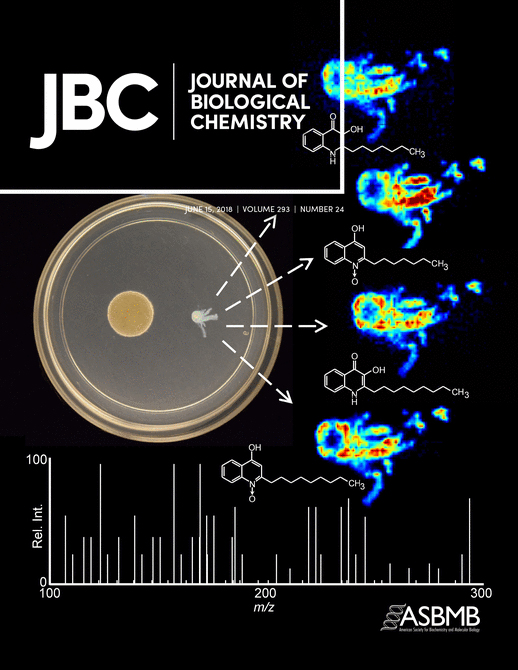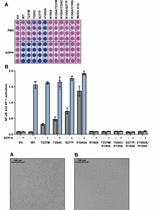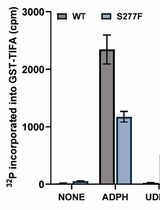- EN - English
- CN - 中文
Quantification of Protein Kinase A (PKA) Activity by An in vitro Radioactive Assay Using the Mouse Sperm Derived Enzyme
用小鼠精子衍生酶体外放射性测定蛋白激酶A(PKA)活性
发布: 2020年06月20日第10卷第12期 DOI: 10.21769/BioProtoc.3658 浏览次数: 4300
评审: David PaulValeria LullaAnonymous reviewer(s)
Abstract
In order to acquire fertilizing potential, mammalian sperm must undergo a process known as capacitation, which relies on the early activation of Protein Kinase A (PKA). Frequently, PKA activity is assessed in whole-cell experiments by analyzing the phosphorylation status of its substrates in a western-blot. This technique faces two main disadvantages: it is not a direct measure of the kinase activity and it is a time-consuming approach. However, since PKA can be readily obtained from sperm extracts, in vitro assays such as the “radioactive assay” can be performed using the native enzyme. Unlike western-blot, the radioactive assay is a straightforward technique to evaluate PKA activity by quantification of incorporated 32P into a peptidic substrate. This approach easily allows the analysis of different agonists or antagonists of PKA. Since mouse sperm is a rich source of soluble PKA, this assay allows a simple fractionation that renders PKA usable both for in vitro testing of drugs on PKA activity and for following changes of PKA activity during the onset of capacitation.
Keywords: Protein Kinase A (PKA) (蛋白激酶A(PKA))Background
Mammalian sperm are not able to fertilize an oocyte immediately after ejaculation. In order to acquire fertilization competence, they must undergo a series of cellular changes collectively known as capacitation (Stival et al., 2016). This process takes place within the female reproductive tract but can be emulated in the laboratory by incubating spermatozoa in a defined medium containing Ca2+, albumin and HCO3-, i.e., the “capacitation medium” (Visconti et al., 1995). Both HCO3- and Ca2+ act synergistically on a soluble adenylyl cyclase (sAC), producing an elevation of intracellular cAMP levels. Among different targets, cAMP directly activates the Ser/Thr Protein Kinase A (PKA), which acts as a central player orchestrating capacitation signaling events (Buffone et al., 2014). Usually, two different approaches can be used to analyze its activity. One of them relies on western-blots, using commercially available antibodies that detect a consensus phosphorylation sequence of PKA (Krapf et al., 2010). However, the steady-state phosphorylation status of any protein depends on the relative activities of both kinases and phosphatases acting on it. Thus, this approach fails to directly analyze actual PKA activity. A second approach involves measuring in vitro PKA activity by direct quantification of 32P incorporated into a peptidic substrate, in a controlled reaction mixture containing phosphatase inhibitors (Stival et al., 2018). This allows analysis of PKA independently of other factors that could modulate the phosphorylated state of the substrate. The chemical nature of the peptidic substrate named Kemptide, named after Dr Kemp, who first synthesized it in 1977 (Kemp et al., 1977), includes a phosphorylable serine residue and two arginine on positions -3 and -2, allowing high PKA specificity. In addition, the Kemptide possesses high relative positive charge which accounts for its strong binding to the negatively charged Whatman P81 cellulose paper, simplifying washing of excess radioactive material (Kemp et al., 1977). The enzyme PKA is composed by two regulatory and two catalytic subunits (Akamine et al., 2003; Zhang et al., 2012). Both types of subunits can be found in Triton X-100-soluble and –insoluble fractions of mouse sperm (Visconti et al., 1997). The activity of PKA within the soluble fraction increases during sperm capacitation. However, the activity of PKA that remains in the insoluble fraction does not change during the course of capacitation, and thus, acts as an excellent source of PKA for enzymatic studies (Visconti et al., 1997).
The protocol described herein is used to analyze the effect of agonists or antagonists on PKA activity, using mouse sperm as the source for the kinase, lowering costs while keeping high efficiency. However, this protocol can be easily adapted to analyze variations of PKA activity during the course of sperm capacitation, by using total unfractionated sperm extracts. In this regard, phosphorylation of the Kemptide reflects the given activity of PKA at any stage of capacitation.
Finally, other sources of PKA can also be used, such as purified PKA from plasmid expression.
Materials and Reagents
Note: Unless specified, all reagents are stored at room temperature (RT, 15-25 °C).
- P81 Whatman cellulose chromatography paper (Sigma-Aldrich, catalog number: Z753645 ), in 2 x 2 cm pieces
Note: There should be as many squares as conditions, plus 9 extra squares for controls, all in triplicates. All pieces should be labeled with a pencil to differentiate them after washing. - 7 ml Copolymer Plastic Vial, Unlined White Poly Screw Cap (RPI, catalog number: 125509 )
- Eppendorf tube (1.5 ml and 2 ml)
- 0.45 µm filter
- Male mouse (8-20 weeks old)
- 70% ethanol
- Tris(hydroxymethyl)aminomethane (Tris base) (Cicarelli, catalog number: 1131214 )
- Triton X-100 (Neo Lab, catalog number: 0 1685 )
- NaCl (Cicarelli, catalog number: 750 )
- MgCl2 (Sigma-Aldrich, catalog number: M8266 )
- Adenosine 5′-triphosphate disodium salt hydrate (ATP) (Sigma-Aldrich, catalog number: A7699 ), store at -20 °C
- Sodium orthovanadate (Na3VO4) (Sigma-Aldrich, catalog number: 450243 ), store at -20 °C
- β-Glycerophosphate disodium salt hydrate (G3P) (Sigma-Aldrich, catalog number: G6251 ), store at -20 °C
- Para-Nitrophenyl Phosphate (NPP) (Cayman chemicals, catalog number: 400090 )
- cOmpleteTM, EDTA-free Protease Inhibitor Cocktail (Protease Cocktail) (Roche, catalog number: 4693132001 ), store at 4 °C
- Bovine Serum Albumin fatty-acid free (BSA) (Sigma-Aldrich, catalog number: A7906 ), store at 4 °C
- Adenosine 3′,5′-cyclic monophosphate sodium salt monohydrate (cAMP) (Sigma-Aldrich, catalog number: 3A6885 ), alternatively, 8-BrcAMP or db-cAMP can be used, store at -20 °C
- 3-Isobutyl-1-methylxanthine (IBMX) (Sigma-Aldrich, catalog number: I5879 ), store at -20 °C
- Kemptide (Leu-Arg-Arg-Ala-Ser-Leu-Gly) (Sigma-Aldrich, catalog number: K1127 ), store at -20 °C
- HEPES (Sigma-Aldrich, catalog number: H3375 )
- Trichloroacetic acid (TCA) (BioChemica, catalog number: PAA1431 )
- ortho-Phosphoric acid 85% (Merck, catalog number: 100573 )
- ATP (ATP-32Pγ) 3000 Ci/mmol; 10 mCi/ml (Perkin Elmer, catalog number: BLU502A )
- Specific drugs to be tested in the experiment (inhibitors, agonists, etc.)
- KCl (Sigma-Aldrich, catalog number: S-7653 )
- Na-Pyruvate (Sigma-Aldrich, catalog number: P-4562 )
- CaCl2·2H2O (Sigma-Aldrich, catalog number: C-7902 )
- KH2PO4 (Sigma-Aldrich, catalog number: P-5655 )
- MgSO4·7H2O (Sigma-Aldrich, catalog number: 63138 )
- Glucose (Sigma-Aldrich, catalog number: G-6152 )
- DMSO (Sigma-Aldrich, catalog number: D2650 )
Solutions
For detailed instructions on how to prepare the following solutions, refer to the Recipes heading:
- 1 M Tris pH 7.4
- 3 M NaCl
- 1 M MgCl2
- 1 mM ATP
- 100 mM Na3VO4
- 800 mM Glyceraldehyde 3-phosphate (G3P)
- 500 mM p-Nitrophenyl Phosphate (NPP)
- 50 mg/ml BSA
- 5 mM Kemptide
- 200 mM HEPES pH 7.3
- 40% TCA
- 5 mM Ortho phosphoric acid
- H-TYH medium (see Recipes)
- Lysis buffer (see Recipes)
- 100 mM IBMX (see Recipes)
- Kinase buffer (see Recipes)
Equipment
- Scintillation Counter (LKB Wallac Rackbeta 1209, catalog number: 0 90161 )
- Neubauer chamber
- Surgery scissors (WPI, catalog number: 14393 )
- Tweezers
- Orbital shake
- Incubator
- Centrifuge
Software
- Microsoft® Office Excel (Microsoft Office 365), or similar
Procedure
文章信息
版权信息
© 2020 The Authors; exclusive licensee Bio-protocol LLC.
如何引用
Readers should cite both the Bio-protocol article and the original research article where this protocol was used:
- Stival, C., Baro Graf, C., Visconti, P. E. and Krapf, D. (2020). Quantification of Protein Kinase A (PKA) Activity by An in vitro Radioactive Assay Using the Mouse Sperm Derived Enzyme. Bio-protocol 10(12): e3658. DOI: 10.21769/BioProtoc.3658.
- Stival, C., Ritagliati, C., Xu, X., Gervasi, M. G., Luque, G. M., Baro Graf, C., De la Vega-Beltran, J. L., Torres, N., Darszon, A., Krapf, D., Buffone, M. G., Visconti, P. E. and Krapf, D. (2018). Disruption of protein kinase A localization induces acrosomal exocytosis in capacitated mouse sperm. J Biol Chem 293(24): 9435-9447.
分类
细胞生物学 > 基于细胞的分析方法 > 酶学测定
细胞生物学 > 细胞信号传导 > 磷酸化
生物化学 > 蛋白质 > 活性
您对这篇实验方法有问题吗?
在此处发布您的问题,我们将邀请本文作者来回答。同时,我们会将您的问题发布到Bio-protocol Exchange,以便寻求社区成员的帮助。
提问指南
+ 问题描述
写下详细的问题描述,包括所有有助于他人回答您问题的信息(例如实验过程、条件和相关图像等)。
Share
Bluesky
X
Copy link















